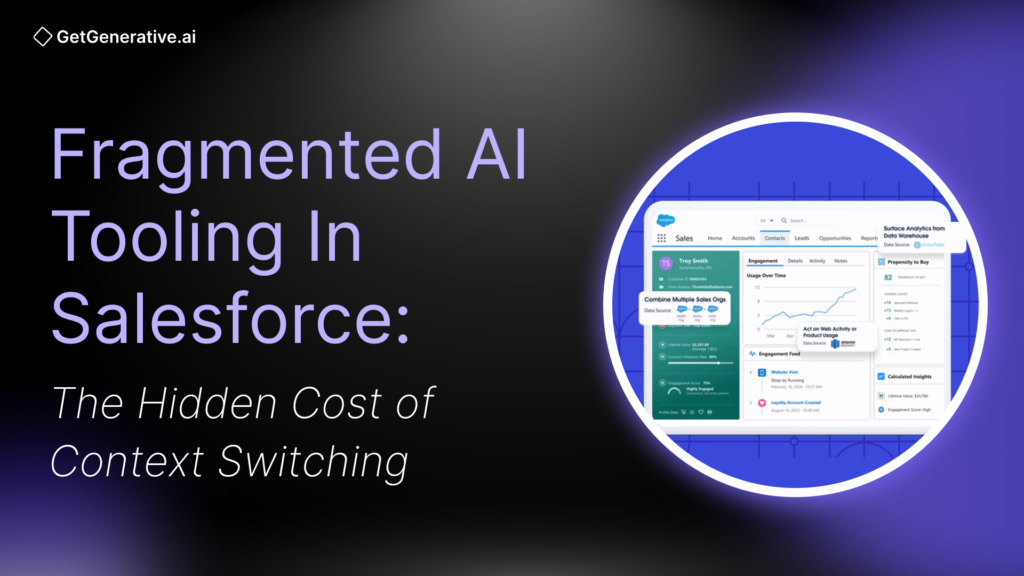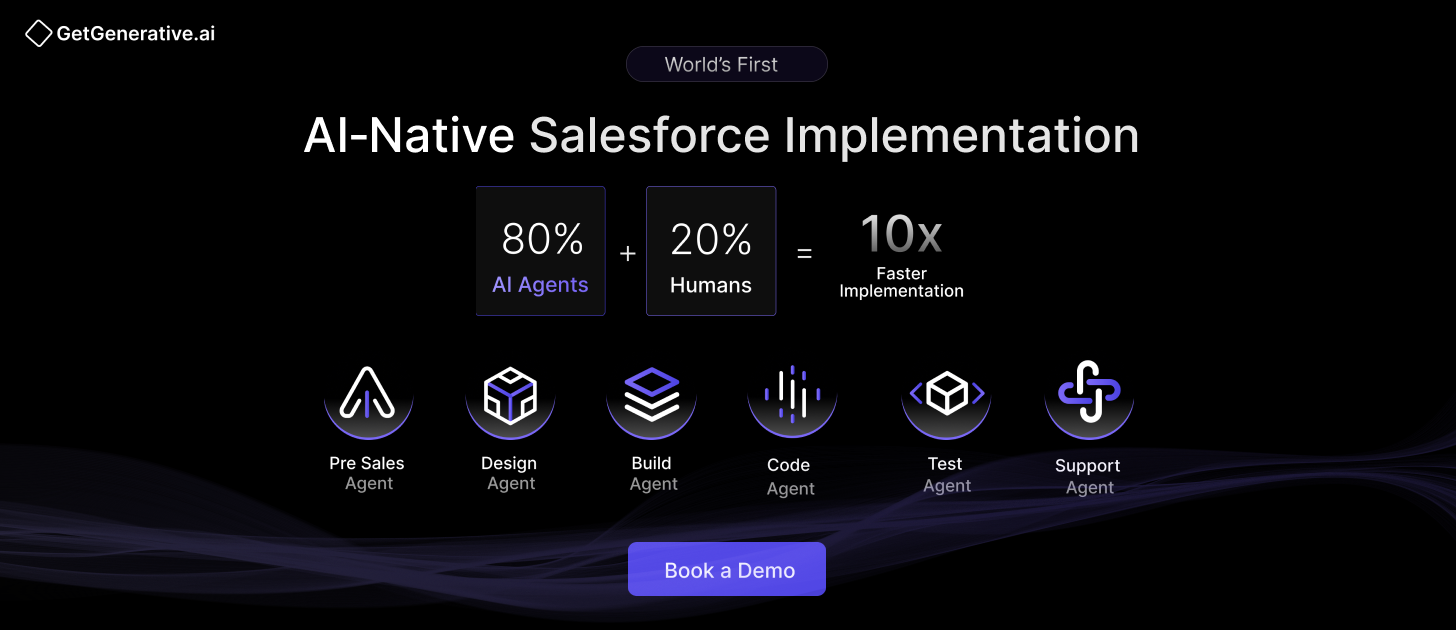Fragmented AI Tooling in Salesforce: The Hidden Cost of Context Switching
Salesforce environments in 2025 are brimming with AI tools. From Einstein GPT in Sales and Service Cloud to Slack-based copilots and third-party AI assistants, the average enterprise has more AI firepower than ever. In theory, this explosion of AI capability should supercharge productivity. In reality, the opposite often occurs.
Why? Because each tool tends to live in its own silo.
Rather than creating seamless workflows, fragmented AI systems force workers to constantly context-switch, jumping between clouds, apps, and assistants. And the cost of this friction is staggering. According to the Harvard Business Review, knowledge workers switch applications over 1,200 times a day, wasting around 4 hours each week on reorientation alone. Multiply this across thousands of employees, and you’re looking at millions of dollars lost annually—a hidden tax on enterprise productivity.
This blog examines the true cost of fragmented AI tooling and how organizations can regain productivity by consolidating their AI experience, beginning with Salesforce.
What Is Context Switching and Why Does It Hurt?
Context switching refers to the mental shift required to move from one task, tool, or conversation to another. Imagine you’re drafting a customer proposal in Salesforce, then replying to a Slack message, then digging through Google Docs for a case study, only to jump back into Salesforce to check pipeline metrics.
Each switch may take seconds, but studies show the brain needs up to 9.5 minutes to regain full focus afterward.
The cumulative effect?
Massive time loss, reduced work quality, and mental fatigue.
Top Context Switching Costs:
Cost Type | Data / Impact |
Toggle Overhead | ~1,200 app toggles/day per user (Qatalog/Cornell) |
Time Lost | 4 hours/week per user reorienting between tools |
Productivity Drain | Up to 40% of effective work time lost to task switching (HBR, 2021) |
Cognitive Lag | 9.5 mins to regain focus after each switch |
Info Scavenging | 59 mins/day searching for data across siloed apps (RingCentral) |
App Overload | Avg. employee uses 9–10 apps/day (Salesforce, 2023) |
Burnout Risk | Nearly 50% of workers say toggling tools makes them feel less productive (Asana) |
IQ Depletion | Task switching can reduce IQ by up to 10 points (University of London) |
These stats reflect more than inefficiency—they reflect real cost. If a Salesforce user making $100K/year loses even 5% of work time, that’s a $5,000 productivity hit. Across a 1,000-person organization, that’s $5M annually—without a single line-item in the budget.
Salesforce’s Fragmented AI Ecosystem: The Core Problem
Despite its “Customer 360” promise, Salesforce still relies on a sprawling architecture. Sales Cloud, Service Cloud, Marketing Cloud, Slack, Experience Cloud, and countless partner tools rarely share unified workflows. As a result, users constantly toggle—even within the Salesforce platform.
For example, a rep might:
- Use Einstein GPT in Sales Cloud to draft an email
- Jump to Slack for internal collaboration
- Access Service Cloud to view customer cases
- Reference a Google Doc or Notion database for context
Each jump fragments focus and worsens the AI experience. It’s no surprise that 45% of users say they’d use generative AI more if it were integrated into their current tools, But 60% of IT leaders say it still isn’t.
This disconnect makes AI feel like a bolt-on, not a built-in.
“Every context switch can knock off 20–80% of productivity.”
— Paraphrased from psychologist Gerald Weinberg
AI Sprawl and Redundant Tooling: Paying Twice for the Same Job
Many companies are layering multiple AI tools onto Salesforce without a unifying framework. Einstein GPT may be in play for predictions, while separate GPT copilots draft content, and analytics tools run on standalone LLMs. It’s no surprise then that:
- The average enterprise uses 991 apps
- 80% of businesses run multiple AI models
- Vendors often charge for similar AI functionality under different SKUs
This leads to what one Gartner analyst called “AI sprawl”—where disconnected models do overlapping work, and pricing becomes opaque.
How Salesforce Cut Context Switching with Embedded AI
Salesforce isn’t just selling AI—it’s using it. In a major internal push called “Customer Zero,” Salesforce deployed Slack-native Einstein bots for HR and IT support. In just three months, the Slack AI assistant:
- Handled 370,000 queries
- Saved 50,000 employee hours
- Reduced system switches by consolidating answers inside Slack
Also Read – AI-Generated Code: When to Trust It and When to Intervene
Smart Integration in Action: The Einstein Copilot Example
Salesforce’s latest AI embeds are designed to tackle fragmentation head-on. One standout: the Einstein Copilot integrated directly into the V2MOM strategy tool.
Instead of bouncing to ChatGPT or another external assistant, users can generate strategy drafts in place with the cartoon Einstein assistant on the same screen.
- No context switch
- No separate tool
- Just in-flow assistance
Strategies to Reduce AI Fragmentation and Context Switching
To tackle the rising cost of fragmented AI, leading organizations are shifting focus from feature adoption to workflow integration. Below are five strategic recommendations backed by data, internal Salesforce results, and industry best practices.
1. Embed AI in Core Workflows (Where the Work Happens)
Rather than forcing users to toggle between apps, embed AI directly inside daily tools like:
- Salesforce Lightning Experience
- Slack workspaces
- Service Cloud console
- Email clients (e.g., Einstein for Outlook)
“The closer AI is to where work is already happening, the greater its ROI.”
— Brent Leary, CRM Industry Analyst
2. Consolidate Redundant Tools to Shrink the Toggle Tax
Start by auditing your tech stack. MuleSoft found the average enterprise runs 991 applications—a massive source of unnecessary context switching.
Steps to take:
- Map all AI tools by function and overlap
- Eliminate redundant copilots, bots, and add-ons
- Standardize AI use across Salesforce, Slack, and approved LLMs
3. Unify Data and Integrate Systems (Zero-Copy, Federated Access)
Even great AI fails if it’s fed with fragmented, siloed data. 81% of IT leaders say data fragmentation is the biggest barrier to AI effectiveness.
Key tactics:
- Use MuleSoft Anypoint or similar API middleware for real-time integrations
- Adopt Salesforce Data Cloud to connect marketing, service, and sales data
- Add unified search tools (e.g., Coveo, Algolia) to reduce knowledge hunt time
4. Explore Agentic AI (Orchestration Over Siloed Automation)
The next phase of AI is not more tools—it’s AI that works across tools. Enter: agentic AI.
These smart systems can execute tasks across multiple platforms, such as:
- Pulling CRM data from Salesforce
- Cross-referencing documents in Google Drive
- Drafting emails based on meeting notes from Slack
5. Governance, Training, and Change Management
Even the best tools fail without usage guidelines.
Recommendations:
- Create clear AI usage policies (when to use Slack bots vs. CRM tools)
- Offer training on embedded features (Einstein GPT, Slack Copilot)
- Monitor adoption and context switching rates with UX analytics
Real-World ROI
Embedded AI Tool | Use Case | Time Saved | Equivalent Productivity |
Einstein for Slack (Eng) | Internal Q&A (18K queries) | 275,000 hours/year | 130 FTE engineers |
Concierge (IT support) | Ticket resolution | 88,000 cases | 66,000 hours/year |
Einstein Copilot (Sales) | Strategy generation, case drafting | Context-free inputs | Higher adoption (45%+) |
These internal benchmarks prove that when AI is built into workflows, organizations can unlock productivity at scale. Conversely, siloed tooling—even if powerful—can become a bottleneck.
Also Read – The Case for a Unified Orchestration Engine in Salesforce AI Development
Conclusion
The future of Salesforce AI is not in more assistants, but in fewer, smarter, more integrated ones.
Fragmented AI tooling and context switching are stealth productivity killers. They don’t show up on financial statements—but they erode performance, morale, and decision-making across the enterprise.
At GetGenerative.ai, we’ve reimagined Salesforce implementation—built from the ground up with AI at the core. This isn’t legacy delivery with AI added on. It’s a faster, smarter, AI-native approach powered by our proprietary platform.
👉 Explore our Salesforce AI consulting services




